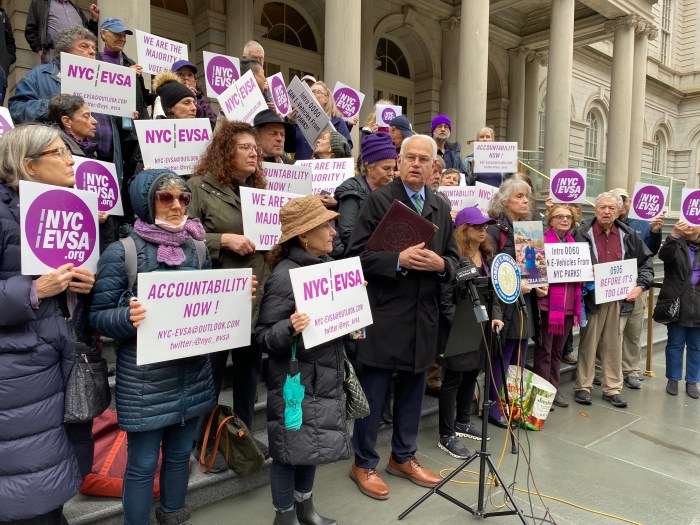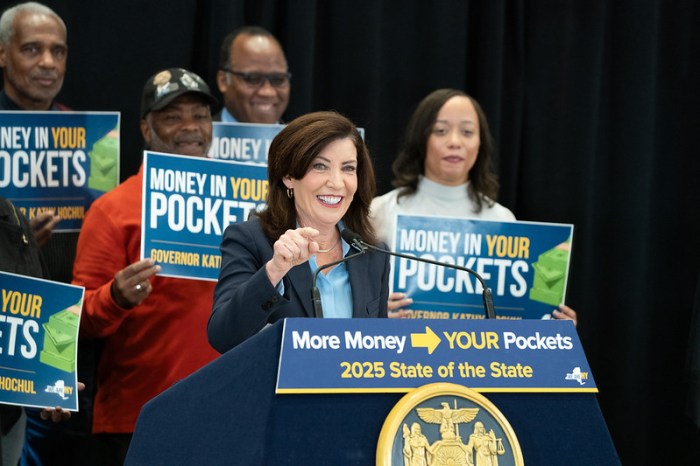The Democratic-controlled state legislature on Wednesday approved their newly drawn plan for New York’s 26 Congressional districts, potentially bringing a process that has stretched on for nearly two years to a close — absent any further legal challenges from Republicans.
Gov. Kathy Hochul signed the maps into law late Wednesday afternoon, according to a post from her government account on X.
The state legislature approved the plan, released on Tuesday, by a 45 to 17 vote in the state Senate and by a 115 to 33 vote in the Assembly. A handful of Republicans joined Democrats in voting the maps through in both chambers.
The new maps are more favorable to Democrats who are trying to flip several key House seats and take back Washington’s lower chamber in the November general election.
House Minority Leader Hakeem Jeffries (D-Brooklyn), who would become speaker if Democrats retake the House, praised the legislature for advancing the plan on Wednesday.
“Today, the state legislature has adopted a bipartisan congressional map that more meaningfully delivers the type of fair representation that the people of New York State deserve,” Jeffries said.
Lawmakers voted on their own maps just two days after rejecting a plan submitted by the state’s Independent Redistricting Commission (IRC), on the grounds that it violated map-making guidelines in the state Constitution in several key areas. Those included splitting up counties, dividing communities of interest and favoring incumbents.
The maps drawn by the IRC — a 10-member panel comprised of an equal number of Democrats and Republicans — were approved by the commission by a nine to one vote earlier this month.
While the new lines drawn by Democratic state lawmakers make some changes that favor their party, the plan leaves 95% of the one drawn by the IRC intact, according to New York Law School professor and redistricting expert Jeffrey Wice.
Nonetheless, some Albany Republicans sharply questioned Democratic leaders on the state Senate and Assembly floors over how the new maps were conceived, while praising the lines drawn by those drawn by the IRC.
State Sen. Anthony Palumbo (R-Suffolk County), before casting his “no” vote, accused Democrats in the legislature of ignoring the will of New York voters, who voted the IRC into existence through a 2014 statewide ballot referendum.
“This ultimately is … only about the process,” Palumbo said. “The voters chose a commission to make this decision. That’s not what we have here.”
Republican upstate Assembly Member Andy Goodell argued that the Democrats’ maneuver essentially does away with the idea of independent redistricting.
“I could use a very graphic demonstration of what I think the majority is doing to that concept of independent redistricting, but I will instead just wave my hand with all my fingers up to say that’s what the majority seems to think about independent redistricting,” Goodell said on the floor, while waving his hand in the air. “‘Goodbye, good riddance, we can do better on our own without any public hearings and without any input.’ And that’s where we are today.”
But Wice said Republicans’ floor arguments against the maps were mostly about structural and procedural questions and given that some voted for the plan, a lawsuit appears less likely.
“It might not be the ideal map that national Democrats were hoping for, but it’s a map that should withstand any possible court challenge,” Wice said.
State Republican Party Chair Ed Cox, in a statement, said that because the Democratic-drawn lines are not “materially different” from the current ones, “there is no need for further litigation.”
Once the governor signs the plan, Wice said, petitioning, which already began under the old maps, can start with the new ones in place.
The plan makes the biggest changes on Long Island and in the Hudson Valley, in battleground districts where Democrats are hoping to pick up Republican seats in November. The districts pertaining to the five boroughs, including the only Republican stronghold in the city represented by U.S. Rep. Nicole Malliotakus (Brooklyn/Staten Island), were left mostly untouched.
On Long Island, recently re-elected U.S. Rep. Tom Suozzi’s 3rd Congressional District, which currently covers northeast Queens and much of northern Nassau County, was extended to include a bluer portion of Suffolk County. Suozzi recently took back his old seat in a heated special election earlier this month and must again fend off a Republican challenger in November.
Meanwhile, the 1st and 2nd Districts on Long Island, which are both held by Republicans, became slightly redder.
In the Hudson Valley, the 19th District, represented by Republican U.S. Rep. Marc Molinaro, was made more Democratic-friendly.
The most notable change within New York City was to the 16th District, which covers much of Westchester County and part of the Bronx. Under the plan, the district — currently represented by U.S. Rep. Jamaal Bowman — gains the large housing development of Co-Op City but loses the neighborhood of Wakefield in the Bronx.
The change, which Wice said amounts to a “population swap,” comes as Bowman is in a heated primary against Westchester County Executive George Latimer.
The vote comes after nearly two years of map-making and court challenges to an earlier set of lines drawn by Democratic legislators in 2022, which were found to be heavily gerrymandered and unconstitutional by the state’s highest court. The maps currently in place were drawn by a court-appointed expert that same year.
Late last year, the state’s highest court ordered the IRC to draw new lines, in a case brought by a group of Democratic voters, determining those drawn by the independent expert were only supposed to be temporary.



































